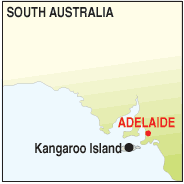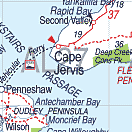|
Australia's third largest island off the Fleurieu Peninsula and a popular holiday resort with
a coastline of around 540km and an area of 4,405 Sq Km.
Access is by ferry from Cape Jervis at the lower point of the Fleurieu Peninsula,
south of Adelaide, or by light plane from Adelaide. Kangaroo Island is South Australia's largest Island and is renowned for its rugged and beautiful scenery and the beaches and fishing which it provides. Seals will be found at Seal Beach and are a popular attraction, and the Koala population of the island is becoming a problem so you will have no trouble seeing these popular creatures on your visit. Accommodation is plentiful, particularly in the host farm sector, and the main towns of Penneshaw and Kingscote have motels and hotels. Many people use the push-bike hire services available to get around the island's roads and towns but you can take your car across from Cape Jervis if you wish. There are 1,600 kilometres of roads on the island, but many of them are unsealed and have rough surfaces. There are also several airstrips and regular services leave Adelaide airport for the island. Kangaroo Island claims to be the first South Australian settlement, as the early colonists stayed there before moving to the more suitable settlement at Glenelg in 1836. There are several lighthouses protecting shipping from the treacherous waters around the island including one at Cape Borda (1858) reached along a 32km loose surface road and offering limited accommodation. SEE TOURING AREA PLACES OF INTEREST: Beatrice Island | Birchmore Lagoon | Bunker Hill | Busby Island | Cape Hart Conservation Park | Edwards Lagoon | Kangaroo Lagoon | | Western Castle Hill Conservation Park | ACCOMMODATION & SERVICES:  ACCOMMODATION & SERVICES:
ACCOMMODATION & SERVICES:
|
|
ADMIRALS ARCH:
A natural arch at Cape du Couedic sculptured by the Southern Ocean, it is a home to New Zealand Fur Seals which can usually be seen. AMERICAN RIVER: American River is near Kingscote and was named by American sealers who sheltered there in the 1800's. There are some excellent examples of early colonial architecture and some of the first lighthouses in the state. CAPE BORDA LIGHTHOUSE: (1858) Standing on a cliff 155 metres above the ocean on the far wesern end of the island at the northern end of the Flinders Chase National Park, there is a small cemetery nearby and a cannon which was used to warn ships of danger if they came too close to the coastline. The Cape Borda Heritage Museum reflects the early days of the settlement and the history of the lighthouse. CAPE GANTHEAUME CONSERVATION PARK: (21,254 hectares) Located on the Central south east of the coastline of the island it extends inland to Murray Lagoon and includes mallee and heathlands and rugged coastline with tall eroded cliffs and eroded caves. Kangaroos, pigmy possums and bandicoots can be seen and access is by foot only. D'ESTREES BAY: Once the site of a whaling station it is a long, sweeping bay with a splendid beach. Several shipwrecks are located off the bay. EUCALYPTUS FACTORY: Near Kingscote a factory still extracts eucalyptus oil using 19th. century technology. FLINDERS CHASE NATIONAL PARK: This 74,000 hectare National Park will be found at the western end of the island and is natural forest land with prolific flora and fauna and many spectacular natural features. The rugged coastline is an ideal haven for sea lions and migratory birds. Cape Barren Geese, Osprey and sea-eagles will be seen and the park contains kangaroos, wallabies, koalas, echidnas and platypus. The breathtaking scenery and wilderness environment are perfect for bush-walking the many trails in the park. Camping is allowed with permission from from the park ranger's office at Rocky Point. HOPE COTTAGE: Located in an historic homestead, this National Trust Museum remembers the history of the island and early settlement. KELLY HILL CONSERVATION PARK: (6306 hectares) In the south-western corner of the island, the park is mainly heathland and contains the KELLY HILL CAVES, a collection sink holes and limestone caves with stalactites and stalagmites. Guided tours of the caves are conducted daily LITTLE SAHARA: An area of white sand dunes off the Seal Bay Road surrounded by bushland. MULBERRY TREE: South Australia's first European tree, a mulberry planted in the 1800's will be found on the island. The tree still bears fruit. REMARKABLE ROCKS: As the name suggest this spectacular collection of rocks has been eroded by time and the elements into 'remarkable' shapes. The rocks are at Cape du Couedic at the south-western end of the island. ROCKY RIVER: A clear area in the Flinders Chase National Park where the ranger station for the park will be found. Kangaroos and Cape Barren Geese congregate here to feed and some of the kangaroos can be hand fed. SEAL BAY CONSERVATION PARK: (750 hectares) Famed for its large population of rare Australian Sea Lions which are fairly tame and allow visitors to he beach to observe them at close quarters. The colony comprises around 10% of the world population. Guided tours operate and a ranger's hut at the beach provides information on their living habits. As an aquatic reserve, swimming and fishing are prohibited. Like any wild animal, they can be dangerous if approached and care should be taken on your visit. |

|
© Copyright Peter W. Wilkins | |



